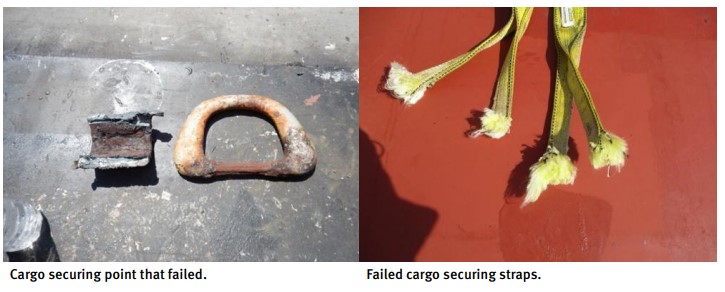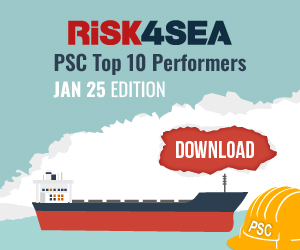The American Club has issued guidance on protecting vessels and cargo to prevent claims due to hazardous and heavy weather.
What’s “heavy weather” for one vessel might not be the same for another vessel, particularly related to vessel motion and the potential for heavy seas to damage the vessel and cargo.
According to the American Club, the risks depend on the vessel’s size, draft, and trim, the stability characteristics for its loaded condition, sea conditions, the shape of the hull, and the vessel’s speed and heading.
Heavy weather has also caused damage to cargo, resulting in cargo-related claims. Data indicates overall that the most common risks to cargo on all types of commercial vessels are physical damage, water damage, and loss of cargo overboard.
Furthermore, for bulk carriers specifically, a common cause of damage to cargo is water ingress from cargo hatch leaks during periods of heavy weather.
When heavy weather is anticipated along the intended route, the mariners, as well as shoreside management, should continuously assess the risks and mitigate them as appropriate.
This includes the following recommended actions:
- Monitor the weather and monitor forecasts from multiple sources.
- Understand the operational limits of the vessel in its currently loaded condition including hull stresses and the condition of hatch covers and seals.
- Know the crew’s readiness and experience in heavy weather.
- Know the cargo’s susceptibility to damage and pay close attention to the cargo stowage arrangement. Additional segregation or separation for incompatible cargo may be appropriate.
- Ensure the cargo securing manual is followed closely.
- Consider utilizing a weather routing service to reduce the risk of encountering heavy Heavy Weather – Protecting the Vessel and Cargo to Prevent Claims weather.
- Ensure the main engine(s), generators, and auxiliary machinery are in good condition. Check that all engine sump oil levels are at the upper end of the recommended range to reduce the risk that vessel motion in heavy weather will cause loss of oil suction.
- Ensure that fuel service tank(s) and fuel settling tank(s) are full and timely replenished.
- Doublecheck the underkeel clearance for the planned route to ensure adequate clearance in rough seas.
- Assess the feasibility of keeping the vessel in port or at a sheltered location until the heavy weather passes.
- Assess the feasibility of stopping cargo operations early to allow the vessel to depart well ahead of expected heavy weather.
When heavy weather is unavoidable, several steps should be taken to reduce the risks:
- Inform the crew of the expected heavy weather, when it will be encountered, and how long the vessel will be in the heavy weather.
- Ensure the crew secures loose items in their staterooms.
- Doublecheck that cargo is properly secured.
- Doublecheck hatch cover securing arrangements and that all doors, access hatches, and other openings are secured and tightened.
- Consider closure/adjustment of cargo hold ventilators to prevent water ingress.
- Consider applying sealing tape or foam sealer as extra weather-tightness protection for the cargo hold hatch covers if the vessel has water-sensitive cargo onboard.
- Test the cargo hold bilge suction system to ensure that it is ready and operational.
- Adjust water ballast to optimize stability.
- Check that all freeing ports are open and that all scupper plugs are removed.
- Check that anchors are housed tightly and secured properly.
- Check that all mooring lines are stowed below decks.
- Ensure that paint, chemicals, drums, and machinery spares are secured.
- Check all lifeboat and liferaft lashings.
- Check all crane lashings.
- Simplify meals to reduce risk to galley personnel.
- Secure the decks and rig lifelines as necessary.
- Consider having extra generators running.
- Consider having all steering motors running.
When the vessel is in heavy weather, vigilance is critically important:
The crew should closely monitor:
- the weather and weather forecasts;
- hull stresses;
- vessel stability;
- the vessel’s roll, pitch, trim, and heel, especially looking for signs of parametric rolling;
- machinery status;
- cargo hold bilge alarms and bilge suction system; and
- cargo lashing gear that is visible without sending crew out on deck or into cargo holds.
- Adjust course and speed as necessary to reduce risk to the vessel and cargo.
- If crew members are sent to secure any items, ensure they go in pairs and never alone, and they should maintain constant contact with the bridge.
- Additional machinery should be kept running, including generators and steering motors.
- Maintain all logs with timely records and critical updates without waiting for the end of the watch period, including water level in cargo hold bilges (if feasible).

If the vessel is at anchor in heavy weather:
- Closely monitor the vessel’s position in case the anchor is dragging.
- Consider paying out extra anchor chain.
- Consider deploying a second anchor.
- Use the main engine and bow thrusters if needed.
- Engines should be on standby and/or short notice.
- Consider the use of a standby tug.
- Consider getting underway and departing the anchorage.
If the vessel is in port during heavy weather:
- Increase the number of mooring lines and use additional bollards where possible.
- Secure and lift the gangway.
- Suspend all cargo operations.
- Consider the use of a standby tug.
- Secure the vessel as if underway in heavy weather.
- Place the main engine and bow thruster on immediate standby.
- Keep extra generators running.
- Document everything done to prepare the vessel and mitigate risks from the heavy weather in port.
Once the vessel is through the heavy weather, or the heavy weather has passed, several actions are recommended. The crew should:
- Assess the condition of all hatches, doors, vents, and other openings.
- Assess the condition of anchors and topside machinery.
- Assess the condition in the cargo holds if it can be done safely.
- Check for the presence of water and pump out cargo hold bilges.
- Assess the condition of all lashings.
- Assess the condition of all cargo.
- Sound all tanks.
- Document everything in the vessel logs and with photos, including any damage or the lack of damage to the vessel or cargo.



























































